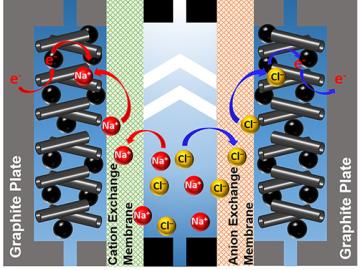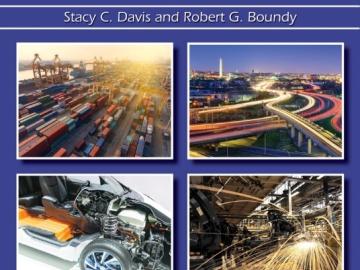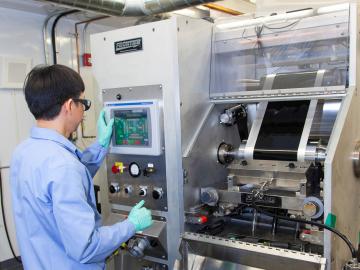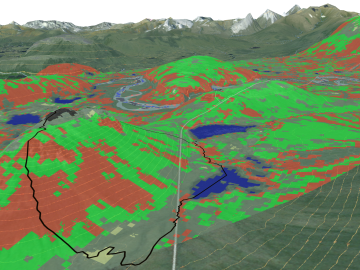
Filter News
Area of Research
- (-) Energy Science (165)
- (-) National Security (24)
- (-) Supercomputing (88)
- Advanced Manufacturing (2)
- Biology and Environment (111)
- Biology and Soft Matter (1)
- Computational Biology (1)
- Computational Engineering (3)
- Computer Science (8)
- Electricity and Smart Grid (1)
- Energy Sciences (1)
- Functional Materials for Energy (2)
- Fusion and Fission (30)
- Fusion Energy (15)
- Isotopes (2)
- Materials (63)
- Materials for Computing (7)
- Mathematics (1)
- Neutron Science (25)
- Nuclear Science and Technology (9)
- Transportation Systems (2)
News Topics
- (-) Energy Storage (74)
- (-) Environment (73)
- (-) Fusion (3)
- (-) Machine Learning (28)
- (-) Mercury (3)
- (-) Simulation (18)
- (-) Summit (44)
- (-) Transportation (72)
- 3-D Printing/Advanced Manufacturing (83)
- Advanced Reactors (8)
- Artificial Intelligence (50)
- Big Data (30)
- Bioenergy (31)
- Biology (22)
- Biomedical (22)
- Biotechnology (7)
- Buildings (39)
- Chemical Sciences (16)
- Clean Water (8)
- Composites (17)
- Computer Science (116)
- Coronavirus (27)
- Critical Materials (12)
- Cybersecurity (28)
- Exascale Computing (27)
- Fossil Energy (2)
- Frontier (32)
- Grid (45)
- High-Performance Computing (46)
- Hydropower (3)
- Isotopes (2)
- Materials (46)
- Materials Science (41)
- Mathematics (4)
- Microelectronics (1)
- Microscopy (14)
- Molten Salt (1)
- Nanotechnology (15)
- National Security (38)
- Neutron Science (22)
- Nuclear Energy (14)
- Partnerships (16)
- Physics (9)
- Polymers (13)
- Quantum Computing (20)
- Quantum Science (27)
- Security (18)
- Software (1)
- Space Exploration (6)
- Statistics (1)
Media Contacts

Using Summit, the world’s most powerful supercomputer housed at Oak Ridge National Laboratory, a team led by Argonne National Laboratory ran three of the largest cosmological simulations known to date.

In a step toward advancing small modular nuclear reactor designs, scientists at Oak Ridge National Laboratory have run reactor simulations on ORNL supercomputer Summit with greater-than-expected computational efficiency.

Ionic conduction involves the movement of ions from one location to another inside a material. The ions travel through point defects, which are irregularities in the otherwise consistent arrangement of atoms known as the crystal lattice. This sometimes sluggish process can limit the performance and efficiency of fuel cells, batteries, and other energy storage technologies.

A team of scientists led by Oak Ridge National Laboratory used carbon nanotubes to improve a desalination process that attracts and removes ionic compounds such as salt from water using charged electrodes.

OAK RIDGE, Tenn., March 11, 2019—An international collaboration including scientists at the Department of Energy’s Oak Ridge National Laboratory solved a 50-year-old puzzle that explains why beta decays of atomic nuclei
Higher carbon dioxide levels caused 30 percent more wood growth in young forest stands across the temperate United States over a decade, according to an analysis led by Oak Ridge National Laboratory.

Oak Ridge National Laboratory’s latest Transportation Energy Data Book: Edition 37 reports that the number of vehicles nationwide is growing faster than the population, with sales more than 17 million since 2015, and the average household vehicle travels more than 11,000 miles per year.

The use of lithium-ion batteries has surged in recent years, starting with electronics and expanding into many applications, including the growing electric and hybrid vehicle industry. But the technologies to optimize recycling of these batteries have not kept pace.

Oak Ridge National Laboratory scientists have created open source software that scales up analysis of motor designs to run on the fastest computers available, including those accessible to outside users at the Oak Ridge Leadership Computing Facility.

A team of scientists led by Oak Ridge National Laboratory used machine learning methods to generate a high-resolution map of vegetation growing in the remote reaches of the Alaskan tundra.


